Advanced Techniques
by Michael Frye | Jan 14, 2019 | Advanced Techniques, Night Photography
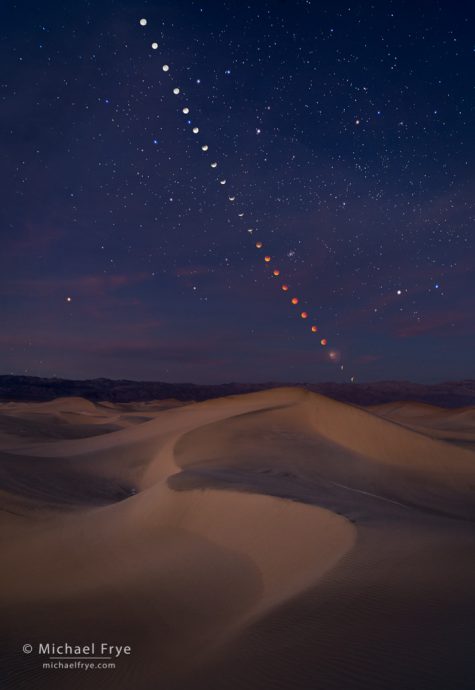
Lunar eclipse sequence over the Mesquite Flat Dunes, January 31st, 2018, Death Valley NP, CA, USA
In case you haven’t heard, there will be a total lunar eclipse on the night of January 20th and 21st, 2019. The totally eclipsed moon will be visible in all of North and South America, most of Europe, and western Africa. This page shows where the eclipse will be visible, as well as the timing of the event.
Here in the western U.S. the eclipse will take place on Sunday evening, January 20th. The peak eclipse occurs at 9:12 p.m. on the west coast, and the moon will be high overhead to the east-southeast. In Yosemite, for example, at peak eclipse the moon will be 47 degrees above the horizon with an azimuth of 102 degrees (just south of due east). In the eastern U.S. the peak eclipse occurs at 12:12 a.m. on the 21st, and the moon will be even higher in the sky – 69 degrees above the horizon in New York City, with an azimuth of 183 degrees (almost due south).
(more…)
by Michael Frye | Oct 31, 2018 | Advanced Techniques, Photography Tips
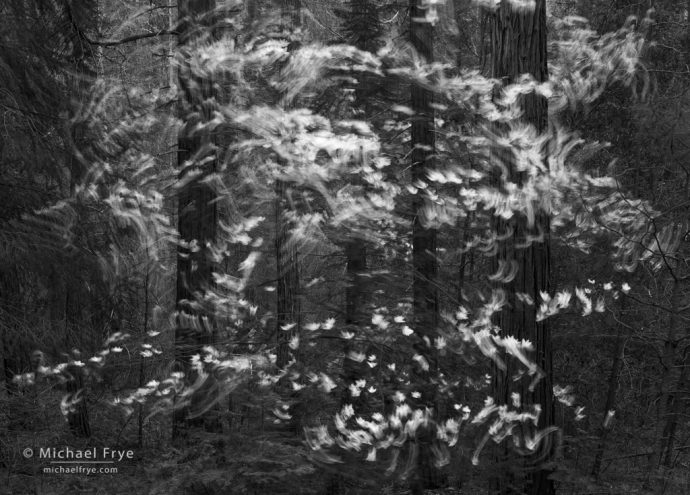
Swirling dogwood blossoms, Yosemite. I used a slow shutter speed (1/2 second) to deliberately blur the motion of these dogwood blossoms, but usually I’m trying to make my photos as sharp as possible.
It’s always disappointing to find out that one of your photos isn’t sharp – especially if it’s an image you like (and you weren’t trying to deliberately blur the image). Yet we all make mistakes. Even professionals like me sometimes take unintentionally blurry photos (as you’ll see below!). But after you’ve swallowed your disappointment, it’s important to figure out why the image is soft so that you don’t make the same mistake again.
There are basically five causes of blurry photos: camera movement, subject movement, missed focus, insufficient depth of field, and lens softness.
(more…)
by Michael Frye | Jan 14, 2018 | Advanced Techniques, Night Photography
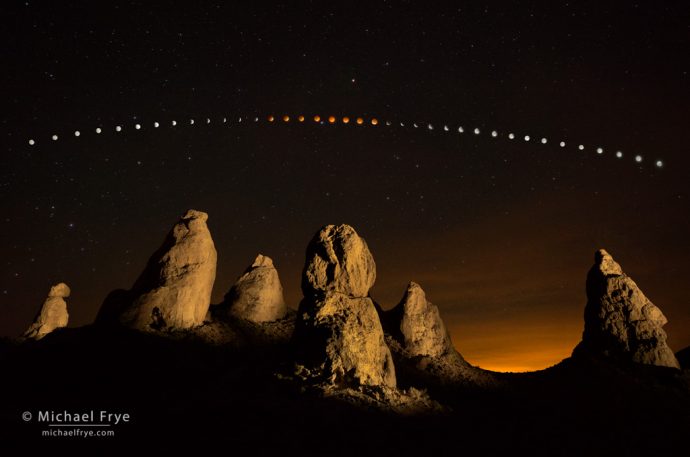
Lunar eclipse sequence, April 14th and 15th, 2014, Trona Pinnacles, CA, USA
In case you haven’t heard, there’s a total lunar eclipse coming up on January 31st. The total eclipse will be visible in central and western North America, Australia, and much of Asia. It will also be a “blue moon,” (the second full moon of the month), and a “supermoon,” (with the moon closer to the earth than normal, so it will look slightly larger). This page shows where the eclipse will be visible, as well as the timing of the event.
In North America the eclipse will occur as the moon is setting in the west just before sunrise. The further west you go, the higher the moon will be during totality, and the longer the eclipse sequence you can see. People in the mountain states should be able to see the entire one hour and sixteen minutes of totality, while those of you in the northwest could see (with clear skies) all of totality plus all of the partial eclipse phase afterwards. Unfortunately, the total eclipse will not be visible on the east coast of the U.S. and Canada.
(more…)
by Michael Frye | Nov 5, 2017 | Advanced Techniques
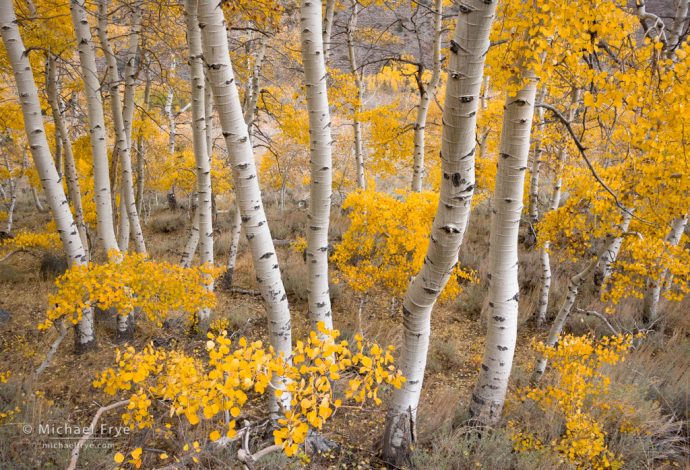
Late-October aspens near Silver Lake, June Lake Loop, Inyo NF, CA, USA. I used f/16 to get everything in focus in this 2008 photograph from the eastern Sierra. (The shutter speed was 1/6th second, the ISO 400.)
I sometimes post my camera settings here on the blog, and I’ve had many people ask me why I often use f/16. Is that the sharpest aperture on my lens? (No.) Don’t you get diffraction at f/16? (A little bit.) Is it for depth of field? (Bingo!)
As many of you know, most lenses are sharpest at middle apertures – generally around f/5.6 to f/11, depending on the lens.
Better lenses will perform decently at wide apertures like f/2.8 or f/4, but usually the corners are softer compared to the middle apertures. On the other end of the spectrum, at smaller apertures diffraction causes all lenses to get softer over the entire image (not just the corners).
(more…)
by Michael Frye | Aug 13, 2017 | Advanced Techniques, Photography Tips
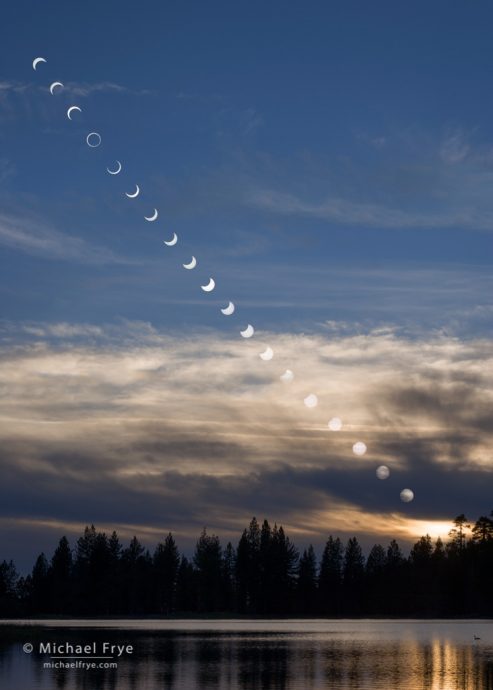
Sequence showing the annular solar eclipse, May 20th, 2012, from Manzanita Lake, Lassen Volcanic NP
The total solar eclipse in the United States is just over a week away (August 21st), and eclipse mania is sweeping the nation. There are many, many articles on the internet describing how to photograph the eclipse (this one by Todd Vorenkamp on the B&H website is the best I’ve found), but I’ll try to cover some topics that haven’t been discussed much elsewhere.
(more…)
by Michael Frye | May 19, 2016 | Advanced Techniques, Night Photography
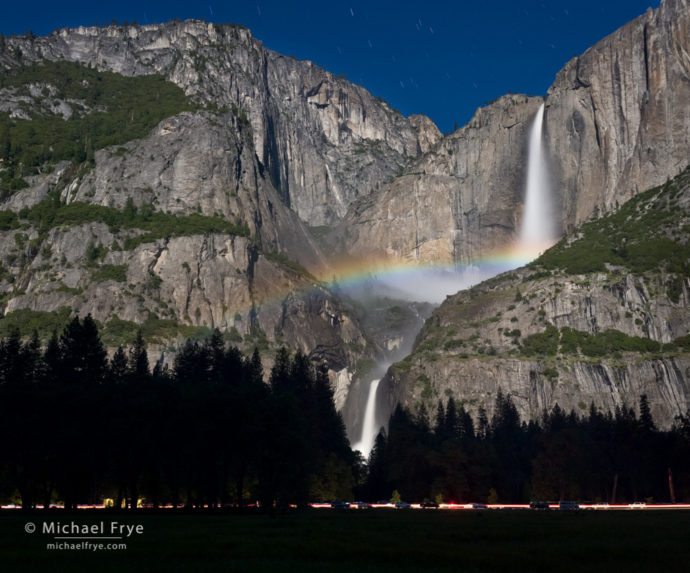
Lunar rainbow from Cook’s Meadow, Yosemite; from June, 2011, a very wet year
Lunar Rainbows and the Milky Way
There will be a full moon this Saturday, and I’m sure many photographers will be heading to Yosemite to photograph the lunar rainbow. Astronomer and “Celestial Sleuth” Don Olson has updated his website to include predictions for when the moonbow will appear on Upper Yosemite Fall from Cook’s Meadow, in addition to his previous predictions for Lower Yosemite Fall.
I think there should be enough spray to make the rainbow visible on Upper Yosemite Fall this month, but probably not in June, when there will be less spray. The Lower Yosemite Fall bridge might work in June, because you don’t need as much water to see a rainbow from that spot, but I expect the bridge will be rather wet this month, which will make it hard to keep spray off the front of your lens. Of course the weather always plays a role, and there are showers in the forecast for this Friday and Saturday nights, so the moonlight might get blocked by clouds. But if you want to try your hand at either location, here are some tips for photographing lunar rainbows.
This is also the beginning of Milky Way season here in the northern hemisphere. The brightest part of the Milky Way can now be seen rising just after 10:30 p.m. here in central California, and will be visible in the evening sky through September.
(more…)














